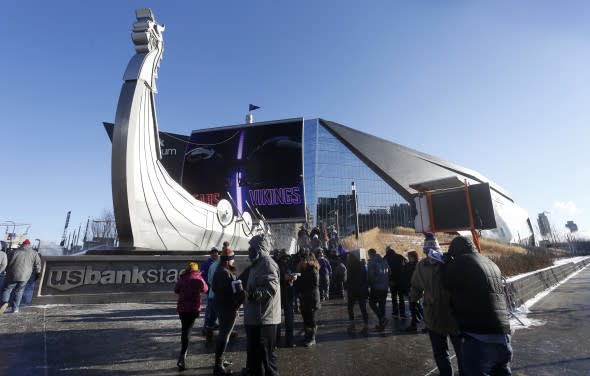Minnesota Vikings' US Bank Stadium features sustainable design, but it has proven deadly for birds
The Minnesota Vikings will host upwards of 70,000 visitors for Super Bowl 52 in their two-year-old U.S. Bank Stadium on Feb. 4. The state-of-the-art stadium is known for being environmentally friendly, but the design has proved to be a threat to birds.
U.S. Bank Stadium is the second NFL stadium to received the Leadership in Energy and Environmental Design (LEED) Gold certification from the U.S. Green Building Council (USGBC).
"Buildings that achieve LEED certification are lowering carbon emissions, creating a healthier environment and reducing operating costs while prioritizing sustainable practices," said Mahesh Ramanujam, president and CEO of USGBC.
The venue, which opened in 2016, reduces its carbon footprint by using less water due to low-flow technology plumbing and saving energy by using LED lighting, which uses 75 percent less energy.

Fans wait outside U.S. Bank Stadium before an NFL football game between the Minnesota Vikings and the Chicago Bears, Sunday, Dec. 31, 2017, in Minneapolis. (AP Photo/Bruce Kluckhohn)
U.S. Bank Stadium has a goal of being a zero-waste facility, where 90 percent of all waste is either compostable or recyclable. In fact, the stadium announced Rush2Recycle, a game plan to recover more than 40 tons of stadium waste during Super Bowl 52.
According to the Vikings, the stadium was designed specifically for the region's climate, as the building's slope was engineered to reduce snow and ice buildup for withstanding Minneapolis' harsh winters.
Although the stadium is one of the most environmentally friendly stadiums in the league, it has proven to be deadly for birds due to its sleek exterior.
The $1.1 billion stadium's shiny reflective windows mirror the sky, clouds and vegetation, which is causing birds to fly into it and die at an alarming rate.
Arguments about bird safety began in 2012, when the design was first revealed to the public.
Despite public petitions, requests from multiple prominent bird conservation organizations and a unanimous resolution from the Minneapolis City Council on Aug. 22, 2014, the Minnesota Sports Facility Authority (MSFA) announced a decision stating they were not going to make any changes to the glass walls of the stadium to protect birds.
U.S. Bank Stadium is located within the Mississippi Flyway, a bird migration route that stretches from Canada to the Gulf of Mexico and Central and South America.
The Audubon Society warned that the stadium's approximately 200,000-square feet of highly reflective glass would be a death trap. They have the data to prove that the stadium is, by far, the deadliest building in Minneapolis.

Audubon Chapter of Minnesota (ACM). Marsh Wren September 26, 2016
Members of three conservation groups, including Audubon Chapter of Minneapolis, Minnesota Citizens for the Protection of Migratory Birds, and Friends of Roberts Bird Sanctuary, monitored the window collisions for approximately four months; however, they were not able to observe the stadium every day due to stadium access restrictions.
During the period of observation, 74 birds of 21 species were recorded. Of these birds, 60 fatalities were observed.
The findings, along with reports from maintenance staff and security guards, show that perhaps as many as 500 birds could possibly be dying annually as a result of the building.
"For comparison, the highest mortality recorded for a single building in Minneapolis during a three-year study of bird-building collisions was 250 birds over six migration periods, averaging 42 birds per migration period," the report reads.
Several groups in the Twin Cities interested in protection of wildlife have been in contact with the Vikings and the Minnesota Sports Facilities Authority (MSFA) since plans for the new stadium were announced. They have offered several proposals, including a switch to bird-safe glass on the exterior walls, which they claim would be a relatively inexpensive change.
"MSFA declined, with the explanation that glass that is bird safe would degrade the game experience for Vikings fans," Stephen Greenfield, spokesperson with Friends of Roberts Bird Sanctuary Audubon Chapter of Minneapolis told AccuWeather.
"We originally suggested 'fritted' glass, which is available from the same Minnesota manufacturer that had the glass contract for the stadium. Fritted glass was also used to retrofit the Javits Convention Center in New York with great success," Greenfield said.
This new stadium may have left 74 birds dead or injured in just 11 weeks. #WorldWildlifeDay pic.twitter.com/L47RR8bBvh
— AJ+ (@ajplus) March 4, 2017
"...Our next step has been to facilitate site visits beginning this spring by a number of national bird experts to research methods of retrofitting U.S. Bank Stadium to prevent bird collisions," Greenfield said.
